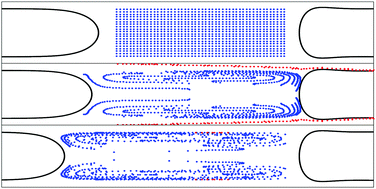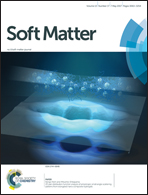The hydrodynamics of segmented two-phase flow in a circular tube with rapidly dissolving drops†
Abstract
This article discusses boundary integral simulations of dissolving drops flowing through a cylindrical tube for large aspect ratio drops. The dynamics of drop dissolution is determined by three dimensionless parameters: λ, the viscosity of the drop fluid relative to the suspending fluid; Ca, the capillary number defining the ratio of the hydrodynamic force to the interfacial tension force; and k, a dissolution constant based on the velocity of dissolution. For a single dissolving drop, the velocity in the upstream region is greater than the downstream region, and for sufficiently large k, the downstream velocity can be completely reversed, particularly at low Ca. The upstream end of the drop travels faster and experiences greater deformation than the downstream end. The film thickness, δ, between the drop and the tube wall is governed by a delicate balance between dissolution and changes in the outer fluid velocity resulting from a fixed pressure drop across the tube and mass continuity. Therefore, δ, and consequently, the drop average velocity, can increase, decrease or be relatively invariant in time. For two drops flowing in succession, while low Ca drops maintain a nearly constant separation distance during dissolution, at sufficiently large Ca, for all values of k, dissolution increases the separation distance between drops. Under these conditions, the liquid segments between two adjacent drops can no longer be considered as constant volume stirred tanks. These results will guide the choices of geometry and operating parameters that will facilitate the characterization of fast gas–liquid reactions via two-phase segmented flows.



 Please wait while we load your content...
Please wait while we load your content...